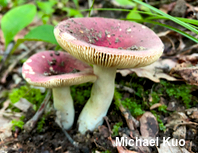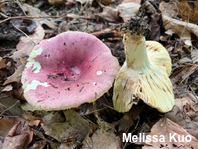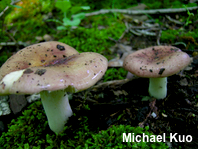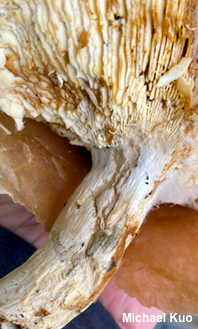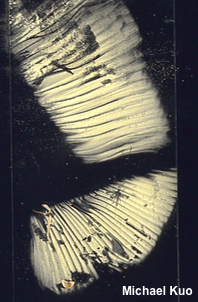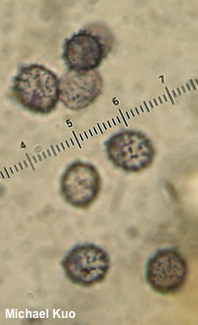| Major Groups > Gilled Mushrooms > Pale-Spored > Russula > Shrimp Russulas > Russula atropurpurea |

|
[ Basidiomycota > Russulales > Russulaceae > Russula . . . ] Russula atropurpurea by Michael Kuo, 3 October 2025 Russula atropurpurea is eastern North America's most common shrimp russula, characterized by its purple cap, fishy odor, brown-staining surfaces, and a color change to green when a drop of iron salts is applied to the stem. It is associated with oaks and other hardwoods, but it often appears in "mixed woods" where sorting out mycorrhizal host trees can be difficult. Species of Russula can be quite variable in their cap colors, and Russula atropurpurea is not an exception; it is usually a shade of purple, but occasionally its cap is brown, or even red, leading to confusion with Russula fucosa. Russula squalida is a synonym. Some North American field guides use the name "Russula atropurpurea" to refer to the species I treat as Russula vinacea (also purple, but not a shrimp russula). The epithet atropurpurea has a long, twisted history of applications; see the extended discussion on the Russula vinacea page if you care. Description: Ecology: Mycorrhizal with oaks and other hardwoods; growing alone or gregariously; summer and fall; originally described from New York (Peck 1888); widely distributed east of the Great Plains in the United States and Canada. The illustrated and described collections are from Illinois and Michigan. Cap: 3.5–11 cm; convex, becoming broadly convex with a shallow central depression; bald at maturity; sticky when fresh; the cuticle peeling easily about one-fourth to one-third the distance from the margin to the center; purple to pinkish purple or purplish pink, sometimes mottled with pinkish and brownish shades; the center often darker than the rest of the cap; the margin not lined, or becoming faintly lined at maturity. Gills: Broadly attached to the stem; close; short-gills absent; whitish, becoming dull yellow; bruising brown. Stem: 3–7 cm long; 1–3 cm thick; equal; dry; bald; white, bruising yellow-brown. Flesh: White; staining slowly brownish when sliced. Odor and Taste: Odor fishy; taste not distinctive. Chemical Reactions: KOH on cap erasing pigment to pale orange. Iron salts on stem surface grayish green. Spore Print: Dull yellow. Microscopic Features: Spores 7–11 x 7–9 µm including ornamentation; ellipsoid; ornamentation as amyloid, mostly isolated warts 0.5–1.0 µm high, with a few scattered connectors; not reticulate. Basidia 32–40 x 9–11 µm; clavate; 4-sterigmate. Pleurocystidia 40–75 x 9–13 µm; fusiform to subcylindric; smooth; thin-walled; contents granular; hyaline in KOH. Pileipellis an ixocutis; elements 2–5 µm wide, smooth, hyaline in KOH; pileocystidia present. REFERENCES: C. H. Peck, 1888. (Kauffman, 1909; Murrill, 1915; Kauffman, 1918; Graham, 1944; Hesler, 1961; Adamčík & Buyck, 2011; Buyck & Adamčík, 2013; Adamčík et al., 2018; Noffsinger et al., 2024.) Herb Kuo 05260402, 06141801, 07282512. This site contains no information about the edibility or toxicity of mushrooms. |
© MushroomExpert.Com |
|
Cite this page as: Kuo, M. (2025, October). Russula atropurpurea. Retrieved from the MushroomExpert.Com Web site: http://www.mushroomexpert.com/russula_atropurpurea.html |
